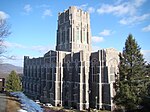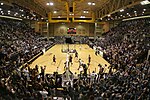Fort Putnam

Fort Putnam was a military garrison during the Revolutionary War at West Point, New York, United States. Built by a regiment of Colonel Rufus Putnam's 5th Massachusetts Regiment, it was completed in 1778 with the purpose of supporting Fort Clinton, which sat on the edge of the Hudson River about 3/4 of a mile away. The fort was rebuilt and enlarged in 1794 before falling into disuse and disrepair as the military garrison at West Point became obsolete in the early mid-19th century. It underwent a major preservation as a historical site in 1909, and has been continually in the process of preservation since. Sitting at an altitude of 500 feet above sea level, it was West Point's largest garrison during the Revolutionary War. The Fort is under the supervision of the West Point Museum Director, David M. Reel, and is operated by the United States Army Garrison, West Point. Access to the Fort is seasonal and as summer staff are available.
Excerpt from the Wikipedia article Fort Putnam (License: CC BY-SA 3.0, Authors, Images).Fort Putnam
Mills Road,
Geographical coordinates (GPS) Address Nearby Places Show on map
Geographical coordinates (GPS)
| Latitude | Longitude |
|---|---|
| N 41.390089 ° | E -73.963923 ° |
Address
Fort Putnam
Mills Road
10996
New York, United States
Open on Google Maps








